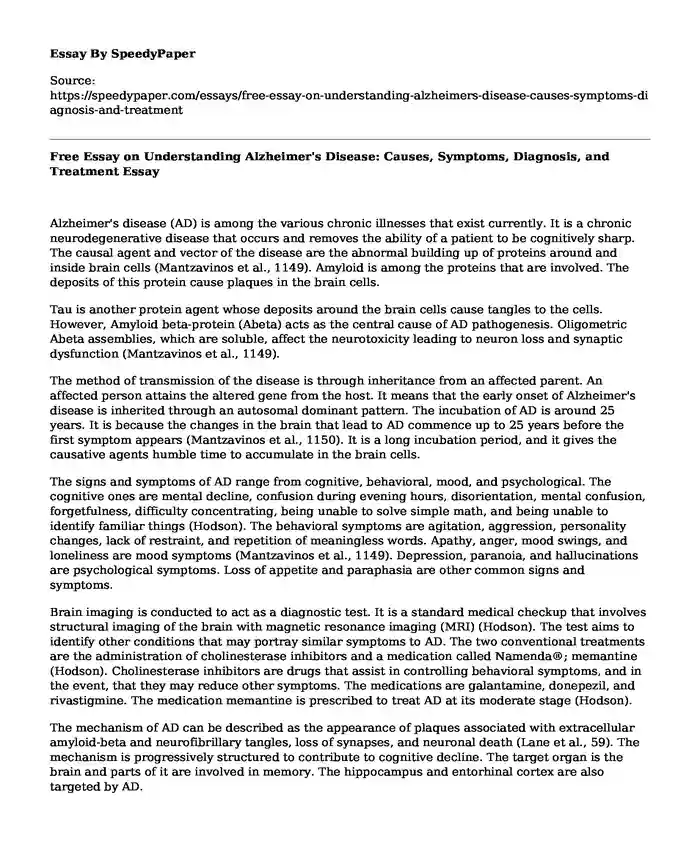
| Type of paper: | Essay |
| Categories: | Health and Social Care Behavior Disorder |
| Pages: | 3 |
| Wordcount: | 619 words |
Alzheimer's disease (AD) is among the various chronic illnesses that exist currently. It is a chronic neurodegenerative disease that occurs and removes the ability of a patient to be cognitively sharp. The causal agent and vector of the disease are the abnormal building up of proteins around and inside brain cells (Mantzavinos et al., 1149). Amyloid is among the proteins that are involved. The deposits of this protein cause plaques in the brain cells.
Tau is another protein agent whose deposits around the brain cells cause tangles to the cells. However, Amyloid beta-protein (Abeta) acts as the central cause of AD pathogenesis. Oligometric Abeta assemblies, which are soluble, affect the neurotoxicity leading to neuron loss and synaptic dysfunction (Mantzavinos et al., 1149).
The method of transmission of the disease is through inheritance from an affected parent. An affected person attains the altered gene from the host. It means that the early onset of Alzheimer's disease is inherited through an autosomal dominant pattern. The incubation of AD is around 25 years. It is because the changes in the brain that lead to AD commence up to 25 years before the first symptom appears (Mantzavinos et al., 1150). It is a long incubation period, and it gives the causative agents humble time to accumulate in the brain cells.
The signs and symptoms of AD range from cognitive, behavioral, mood, and psychological. The cognitive ones are mental decline, confusion during evening hours, disorientation, mental confusion, forgetfulness, difficulty concentrating, being unable to solve simple math, and being unable to identify familiar things (Hodson). The behavioral symptoms are agitation, aggression, personality changes, lack of restraint, and repetition of meaningless words. Apathy, anger, mood swings, and loneliness are mood symptoms (Mantzavinos et al., 1149). Depression, paranoia, and hallucinations are psychological symptoms. Loss of appetite and paraphasia are other common signs and symptoms.
Brain imaging is conducted to act as a diagnostic test. It is a standard medical checkup that involves structural imaging of the brain with magnetic resonance imaging (MRI) (Hodson). The test aims to identify other conditions that may portray similar symptoms to AD. The two conventional treatments are the administration of cholinesterase inhibitors and a medication called Namenda®; memantine (Hodson). Cholinesterase inhibitors are drugs that assist in controlling behavioral symptoms, and in the event, that they may reduce other symptoms. The medications are galantamine, donepezil, and rivastigmine. The medication memantine is prescribed to treat AD at its moderate stage (Hodson).
The mechanism of AD can be described as the appearance of plaques associated with extracellular amyloid-beta and neurofibrillary tangles, loss of synapses, and neuronal death (Lane et al., 59). The mechanism is progressively structured to contribute to cognitive decline. The target organ is the brain and parts of it are involved in memory. The hippocampus and entorhinal cortex are also targeted by AD.
Depression is among the differential diagnoses of AD. This is because the clinical manifestation of depression overlaps with that of AD. Also, cognitive dysfunction, which is evident in AD, can be caused by depression (Lane et al., 59). However, the difference is that depression in AD is oriented toward motivational disturbance such as psychomotor slowing, while depression in geriatric patients is oriented toward mood symptoms (Lane et al., 59).
Observable development in AD is that its treatment has changed. Currently, ad treatment targets the microscopic clumps of protein beta-amyloid (Lane et al., 59). Drugs such as monoclonal antibodies have been invented to help clear beta-amyloid from the brain cells.
Works Cited
Hodson, Richard. "Alzheimer's disease." Nature vol. 559,7715 (2018): S1. doi:10.1038/d41586-018-05717-6
Lane, C A et al. "Alzheimer's disease." European Journal of Neurology vol. 25,1 (2018): 59-70. doi:10.1111/ene.13439
Mantzavinos, Vasileios, and Athanasios Alexiou. "Biomarkers for Alzheimer's Disease Diagnosis." Current Alzheimer Research, vol. 14,11 (2017): 1149-1154. doi:10.2174/1567205014666170203125942
Cite this page
Free Essay on Understanding Alzheimer's Disease: Causes, Symptoms, Diagnosis, and Treatment. (2023, Nov 05). Retrieved from https://speedypaper.com/essays/free-essay-on-understanding-alzheimers-disease-causes-symptoms-diagnosis-and-treatment
Request Removal
If you are the original author of this essay and no longer wish to have it published on the SpeedyPaper website, please click below to request its removal:
- Essay Example on Rugby Sport and Performance Enhancement Drugs
- Free sample: Pneumonia Nursing Care Plan
- Paper Example. Management and Employee Satisfaction
- Essay Sample on Effects of Addiction on One's Psychology
- Symptom History - Free Essay Example
- Essay on Essential Nutrients for Different Age Groups: A Guide
- Essay Sample on Factors Causing Maldistribution
Popular categories




